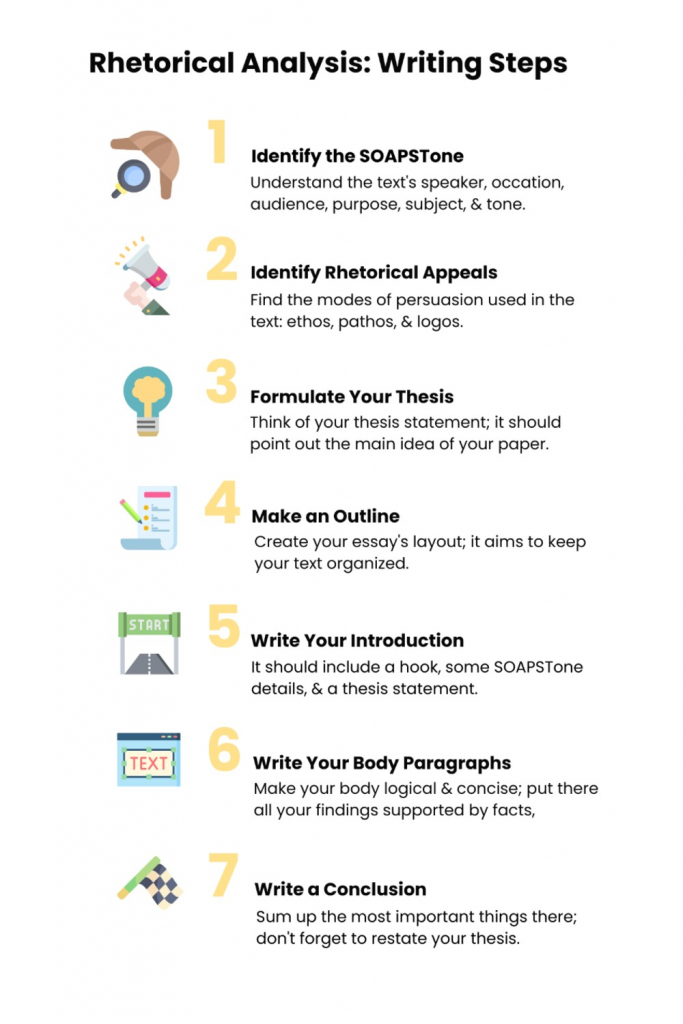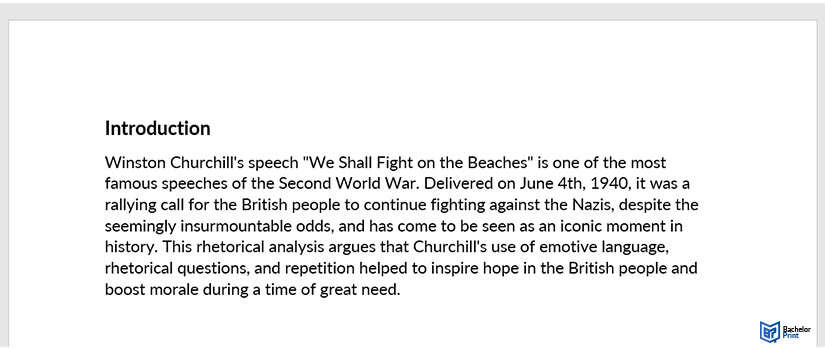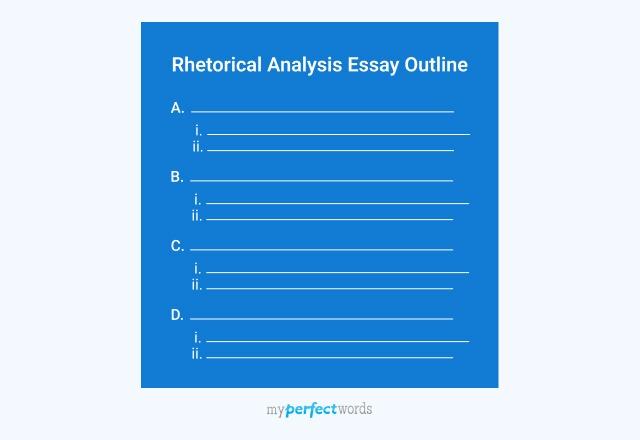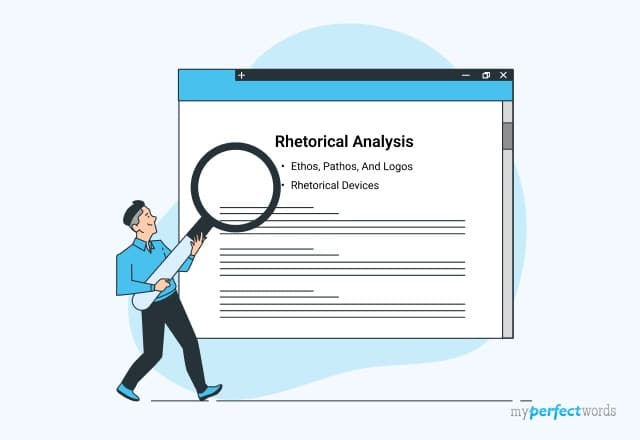How to Write a Rhetorical Analysis Essay: Outline, Steps, & Examples
If you are assigned to write a rhetorical analysis essay, you have one significant advantage. You can choose a text from an almost infinite number of resources. The most important thing is that you analyze the statement addressed to an audience. The task of a rhetorical analysis essay is to identify the speaker’s main objectives. However, it is also crucial to work through the rhetorical strategies the speaker uses.
In this article by Custom-Writing.org experts, you will get to know the SOAPSTone and rhetorical appeals. This is included in our seven-step guide on how to write a rhetorical analysis essay. You’ll find out the essential tips on formatting and formulating the thesis statement. There are also a rhetorical essay outline and examples at the end for your reference!
- ❓ What Is Rhetorical Analysis?
- 👣 Writing Steps
- 👀 Essay Examples

🔗 References
❓ what is a rhetorical analysis essay.
In a rhetorical analysis essay, you have to divide a text into parts and explain whether they work together or not . It is quite different from a usual literary analysis . The task is to find out how successful the speaker is at reaching their objective.
How to Write a Rhetorical Analysis Essay: Main Steps
There are several steps you should follow to hit the highest score for your essay. First, you should work with SOAPSTone and rhetorical appeals. Then, you should proceed with basic tasks, such as writing a thesis statement and outline. When you have these done, it’s time to put it all together into the three main parts of the essay.

Step #1: Identify the SOAPSTone of the Text
SOAPSTone is a very handy tool to help you understand the text you are dealing with. The following questions allow you to gather all the information you will need for future analysis.

Step #2: Identify Rhetorical Appeals Used in the Text
Rhetorical appeals are also known as “modes of persuasion” and include ethos, pathos, and logos. They can be understood as tools for making others believe a particular point of view. Some of the most potent examples can be found in advertisements.
Ethos is related to the speaker’s credibility. Mentioning some impressive qualifications or years of practice reassures the reader of the speaker’s reliability and trustworthiness. It helps to persuade the audience.
For example, a doctor might write an article about the surgery success rate after 30 years of practicing in the field. Demonstrating one’s expertise like this is an excellent example of ethos.
Pathos is all about emotions. Evoking deep feelings in the listeners is a powerful tool, which helps the speaker convince them. The range of emotions varies from love, admiration, and sympathy to anger and hate. Whenever the response from the audience aligns with what the speaker is expecting, it is a win. Usually, it is achieved by using provocative language.
For instance, a mayoral candidate shouts out into the crowd that hundreds of people could lose their jobs if they don’t do something. The speaker aims to make the audience feel resentful of the current situation and sympathetic to a new plan. This way, they are more likely to vote for this candidate since they feel passionate about the promises.
Emotions are not always enough to convince someone to follow you, are they? Therefore, the last crucial mode is logos. Logos is responsible for logic. Appealing to reason is mostly used in an academic environment , but it’s not uncommon in other fields. The speaker could use reliable data , facts, and evidence to convince the audience.
Using numbers is always a good idea. For example, during the presentation, the speaker can include some graphs and percentages: “Last year, we finished 23% of projects ahead of schedule, saving over two million dollars for our customers.”
Step #3: Formulate Your Thesis Statement
Remember that your thesis statement is considered to be the front page of your paper. When successfully composed, it points out the main idea of your essay. Therefore, it has to be as clear and specific as possible.
You want to include everything you found out about the chosen text in this single sentence. If you didn’t skip the first two steps, it shouldn’t be a problem! A decent thesis statement would look like this:
“In her article, the writer mentions her expertise and up-to-date statistics, and appeals to the readers’ pity to convince them of the necessity of regular yearly check-ups for disease prevention.”
Don’t worry if you still can’t come up with anything decent. try using a rhetorical analysis thesis generator that will give you some ideas of what direction you should take in your writing.
Step #4: Create Your Rhetorical Analysis Essay Outline
Even though keeping your essay organized is not your most important task, it is undoubtedly helpful! If you don’t want to forget anything and save yourself quite a lot of time, follow our advice and write an outline . This can be especially helpful if you mostly use visual memory.
Introduction, main body, and conclusion create the basic layout of any essay. The main body of the paper includes at least three paragraphs. The rhetorical analysis essay outline also fits this rule.
Carefully go through all the notes you’ve made and mark the main points you want to include in your essay. Think about the evidence you have to support them. Along with the thesis statement, write it all down in a format of a list. When you are done with it, you may use it as a cheat sheet during the next steps of the writing process.
Now, you’re all set up and ready to begin writing your essay!
Step #5: Write Your Rhetorical Analysis Essay Introduction
There are several things you need to consider when writing an introduction:
- If it’s not your school assignment, let the reader know that it’s a rhetorical analysis.
- Come up with a hook to interest the reader.
- Don’t forget to mention the text or speech you’re analyzing. You can also drop a few facts about it.
- Think of the SOAPSTone details that matter and include them here as well. You don’t have to mention all of the parts, just the ones that make sense to you.
- At the end of the introduction, write your thesis statement . It brings more clarity to this part of the essay.
Step #6: Write Your Body Paragraphs
As usual, this is where you put all your findings and support them with some facts. Don’t forget that there should be at least three body paragraphs . Since it fits the number of rhetorical appeals, you can go ahead and write about ethos, pathos, and logos. Another way of organizing the paragraphs is to present the text’s details chronologically, meaning from beginning to end. In this case, whatever text or speech you chose, it was probably well-prepared, so it helps your analysis look coherent.
It doesn’t matter which option you prefer, but make sure you provide enough support for your arguments . The most effective way to make it work is to use quotes. Also, stick to using the third-person so that you don’t break the rules of academic writing.
You can see how your main points can be organized most effectively in the rhetorical analysis essay sample at the end of the article.
Step #7: Write Your Rhetorical Analysis Essay Conclusion
The purpose of the conclusion is to sum up the most important findings of your analysis . You need to include your thesis statement here as well, but not word-for-word. Aim to paraphrase it and make it seem more sophisticated. This can be achieved by using new terminology. Maybe there is something the readers now understand from your essay that they couldn’t have before.
Then, in the form of a summary, briefly mention the main ideas that support your thesis. You don’t have to be a professional summary typer , just get your idea across in a concise manner. You might add a few words about the importance of your analysis as well. If you think that this issue is worth further research, write that down too.
👀 Rhetorical Analysis Essay: Examples
Below you’ll find an essay aiming to analyze On Women’s Right to Vote by Susan B. Anthony – a speech regarded as one of the best in American history. In this rhetorical analysis essay example, you can see how to put everything together by following the seven-step guide above. Here, the main body is divided into three paragraphs presenting one rhetorical appeal each.
Here are some other essay examples for you to check out.
- Obama Speech: Rhetorical Analysis and Evaluation
- “Get Out” Movie’s Rhetorical Analysis
- Susan B. Anthony’s Speech: Rhetorical Analysis
- Rhetorical Analysis of John F. Kennedy’s Inaugural Address
- Steve Jobs’ Commencement: Rhetorical Analysis
- Blogs on Euthanasia: Rhetorical Analysis
Rhetorical Analysis Essay Topics
- A rhetorical analysis of one of Hallmark’s commercials.
- Steve Jobs’ speech at Stanford University in 2005: rhetorical analysis.
- The use of rhetorical devices in Gary Shteyngart’s Only Disconnect .
- Rhetorical strategies used in horror film Us by Jordan Peele.
- Analyze Hamlet’s monologues in W. Shakespeare’s The Tragedy of Hamlet, Prince of Denmark .
- Discuss how Martin Luther King Jr. uses rhetorical appeals in his Letter from Birmingham Jail .
- Describe the rhetorical devices used in Greta Thunberg’s speech .
- The common rhetorical aspects used in articles of Carolyn Gregoire and Sophie Reeves.
- Examine the rhetoric in Brooks’ Reading Too Much Political News Is Bad for Your Well-Being .
- Analyse the persuasive devices in Google Analytics App.
- Study the application of rhetorical strategies in Beyond Vietnam: A Time to Break Silence by Martin Luther King, Jr .
- Compare the lyrics rhetoric in The Times They Are A-Changing and The Wind of Change .
- Rhetorical analysis for applying critical thinking.
- Describe the rhetorical devices used in Confessions of a Female Chauvinist Sow by Anne Roiphe.
- Examine the persuasive techniques in the Gillette commercial We Believe: The Best Men Can Be .
- Compare the rhetorical schemes of Abraham Lincoln’s Second Inaugural Address and Emily Dickinson’s Success is Counted Sweetest .
- Rhetorical analysis of Media Control by Noam Chomsky.
- Analyse the persuasive devices used in political debates The Issue of Women and Race (2019).
- Rhetorical appeal in Andrew Cadelago’s film Snack Attack .
- Discuss the rhetorical strategies in Hidden Intellectualism by Gerald Graff.
- Analyse the persuasive devices used in Angelina Jolie’s speech on female empowerment.
- Describe the rhetorical appeals applied by Steinbeck in Of Mice and Men to stir up the emotions of the readers.
- Compare the rhetoric of Margaret Fuller and Fredrick Douglass.
- Body by Milk and Moms Demand Action advertising campaigns: rhetorical analysis.
- Describe the use of three appeals in Coors Light Beer ad.
- Discuss the persuasive tactics in the 1950s advertising with Marilyn Monroe.
- Analyze the rhetorical strategies in Aveeno advertisement.
- Examine the efficiency of persuasive devices in the Stop Bullying public campaign.
- The instruments used to persuade the audience in Anti-Drug Abuse public campaign.
- Explore the rhetorical appeals in Julius Caesar by W. Shakespeare .
- Analyze the persuasive strategies of FIFA franchise.
- Rhetoric of The American Scholar by Ralph Waldo Emerson.
- Describe the rhetorical devices that made Pericles’ Funeral Oration one of the world’s most influential speeches.
- Persuasive techniques in American Crisis by Thomas Paine.
- Analyze the rhetorical strategies used by Linda Hogan in Dwellings .
- Explore the modes of persuasion in Narrative of the Life of Frederick Douglas .
- The Myth of the Charioteer : rhetorical analysis.
- Discuss the rhetorical appeals of Pop Can: Popular Culture in Canada .
- The three appeals in Claire Giordano’s Virtual Promise .
- Rhetorical devices in the film Henry V (1944) directed by Laurence Olivier.
- Describe the rhetoric technique used by Michelle Obama in her TED speech.
- Analyze the persuasive tactics in James Q. Wilson’s Just Take Away Their Guns .
- Compare the rhetorical strategies in Moore’s Idiot Nation and Gatto’s Against School .
- What in the world is a rhetorical analysis? – NC State University
- Rhetorical Analysis – Stanford University
- Rhetorical Strategies // Purdue Writing Lab
- Rhetorical Analysis – Writers Workshop (Illinois)
- Rhetorical Analysis – SAGE Research Methods
- Rhetorical Analysis | Department of English | University of Washington
- Doing a Rhetorical Analysis of a Text (CSU)
- Aristotle’s Rhetorical Situation // Purdue Writing Lab
- Ethos, logos, pathos: Strategies of persuasion in social/environmental reports
- Share to Facebook
- Share to LinkedIn
- Share to email

Any literary analysis is a challenging task since literature includes many elements that can be interpreted differently. However, a stylistic analysis of all the figurative language the poets use may seem even harder. You may never realize what the author actually meant and how to comment on it! While analyzing...

As a student, you may be asked to write a book review. Unlike an argumentative essay, a book review is an opportunity to convey the central theme of a story while offering a new perspective on the author’s ideas. Knowing how to create a well-organized and coherent review, however, is...

The difference between an argumentative and persuasive essay isn’t always clear. If you’re struggling with either style for your next assignment, don’t worry. The following will clarify everything you need to know so you can write with confidence. First, we define the primary objectives of argumentative vs. persuasive writing. We...

You don’t need to be a nerd to understand the general idea behind cause and effect essays. Let’s see! If you skip a meal, you get hungry. And if you write an essay about it, your goal is achieved! However, following multiple rules of academic writing can be a tough...
![rhetorical analysis essay steps How to Write an Argumentative Essay: 101 Guide [+ Examples]](https://custom-writing.org/blog/wp-content/uploads/2021/01/young-writer-taking-notes-284x153.jpg)
An argumentative essay is a genre of academic writing that investigates different sides of a particular issue. Its central purpose is to inform the readers rather than expressively persuade them. Thus, it is crucial to differentiate between argumentative and persuasive essays. While composing an argumentative essay, the students have to...
![rhetorical analysis essay steps How to Title an Essay: Guide with Creative Examples [2024]](https://custom-writing.org/blog/wp-content/uploads/2021/01/close-up-woman-making-greeting-card-new-year-christmas-2021-friends-family-scrap-booking-diy-writing-letter-with-best-wishes-design-her-homemade-card-holidays-celebration-284x153.jpg)
It’s not a secret that the reader notices an essay title first. No catchy hook or colorful examples attract more attention from a quick glance. Composing a creative title for your essay is essential if you strive to succeed, as it: Thus, how you name your paper is of the...

The conclusion is the last paragraph in your paper that draws the ideas and reasoning together. However, its purpose does not end there. A definite essay conclusion accomplishes several goals: Therefore, a conclusion usually consists of: Our experts prepared this guide, where you will find great tips on how to...
![rhetorical analysis essay steps How to Write a Good Introduction: Examples & Tips [2024 Upd.]](https://custom-writing.org/blog/wp-content/uploads/2021/01/closeup-shot-woman-working-studying-from-home-with-red-coffee-cup-nearby-284x153.jpg)
A five-paragraph essay is one of the most common academic assignments a student may face. It has a well-defined structure: an introduction, three body paragraphs, and a conclusion. Writing an introduction can be the most challenging part of the entire piece. It aims to introduce the main ideas and present...

Exemplification essays, also called illustration essays, are one of the easiest papers to write. However, even the simplest tasks require experience and practice. It is a good idea to find and analyze free exemplification essay examples. You can also ask your teacher to give you some sample exemplification essays from...
![rhetorical analysis essay steps How to Write about a Topic You Lack Interest in [2024]](https://custom-writing.org/blog/wp-content/uploads/2021/01/Frustrated-exhausted-young-woman-blogger-284x153.jpg)
During their school years, students may not always have the opportunity to select a topic for their essay or research paper. Instructors tend to assign one or offer a list of ideas that might not seem engaging. Moreover, even the topic that you choose yourself can sometimes end up being...

Sorry to disappoint you, but if you think that your high scores and grades would be enough to get accepted into the university of your dreams, you’re wrong… The best colleges worldwide, such as the Ivy League schools receive applications from thousands and thousands of talented students. You gotta stand...

Writing an essay is a task that everyone has to deal with. The first encounter most likely happens at primary school. Compositions in primary school are quite basic and only require a good imagination and somewhat decent writing skills. But… As time passes, essay writing becomes more and more complicated....
- Affiliate Program

- UNITED STATES
- 台灣 (TAIWAN)
- TÜRKIYE (TURKEY)
- Academic Editing Services
- - Research Paper
- - Journal Manuscript
- - Dissertation
- - College & University Assignments
- Admissions Editing Services
- - Application Essay
- - Personal Statement
- - Recommendation Letter
- - Cover Letter
- - CV/Resume
- Business Editing Services
- - Business Documents
- - Report & Brochure
- - Website & Blog
- Writer Editing Services
- - Script & Screenplay
- Our Editors
- Client Reviews
- Editing & Proofreading Prices
- Wordvice Points
- Partner Discount
- Plagiarism Checker
- APA Citation Generator
- MLA Citation Generator
- Chicago Citation Generator
- Vancouver Citation Generator
- - APA Style
- - MLA Style
- - Chicago Style
- - Vancouver Style
- Writing & Editing Guide
- Academic Resources
- Admissions Resources
How to Write a Rhetorical Analysis Essay–Examples & Template
What is a Rhetorical Analysis Essay?
A rhetorical analysis essay is, as the name suggests, an analysis of someone else’s writing (or speech, or advert, or even cartoon) and how they use not only words but also rhetorical techniques to influence their audience in a certain way. A rhetorical analysis is less interested in what the author is saying and more in how they present it, what effect this has on their readers, whether they achieve their goals, and what approach they use to get there.
Its structure is similar to that of most essays: An Introduction presents your thesis, a Body analyzes the text you have chosen, breaks it down into sections and explains how arguments have been constructed and how each part persuades, informs, or entertains the reader, and a Conclusion section sums up your evaluation.
Note that your personal opinion on the matter is not relevant for your analysis and that you don’t state anywhere in your essay whether you agree or disagree with the stance the author takes.
In the following, we will define the key rhetorical concepts you need to write a good rhetorical analysis and give you some practical tips on where to start.
Key Rhetorical Concepts
Your goal when writing a rhetorical analysis is to think about and then carefully describe how the author has designed their text so that it has the intended effect on their audience. To do that, you need to consider a number of key rhetorical strategies: Rhetorical appeals (“Ethos”, “Logos”, and “Pathos”), context, as well as claims, supports, and warrants.
Ethos, Logos, and Pathos were introduced by Aristotle, way back in the 4th century BC, as the main ways in which language can be used to persuade an audience. They still represent the basis of any rhetorical analysis and are often referred to as the “rhetorical triangle”.
These and other rhetorical techniques can all be combined to create the intended effect, and your job as the one analyzing a text is to break the writer’s arguments down and identify the concepts they are based on.
Rhetorical Appeals
Rhetorical appeal #1: ethos.
Ethos refers to the reputation or authority of the writer regarding the topic of their essay or speech and to how they use this to appeal to their audience. Just like we are more likely to buy a product from a brand or vendor we have confidence in than one we don’t know or have reason to distrust, Ethos-driven texts or speeches rely on the reputation of the author to persuade the reader or listener. When you analyze an essay, you should therefore look at how the writer establishes Ethos through rhetorical devices.
Does the author present themselves as an authority on their subject? If so, how?
Do they highlight how impeccable their own behavior is to make a moral argument?
Do they present themselves as an expert by listing their qualifications or experience to convince the reader of their opinion on something?
Rhetorical appeal #2: Pathos
The purpose of Pathos-driven rhetoric is to appeal to the reader’s emotions. A common example of pathos as a rhetorical means is adverts by charities that try to make you donate money to a “good cause”. To evoke the intended emotions in the reader, an author may use passionate language, tell personal stories, and employ vivid imagery so that the reader can imagine themselves in a certain situation and feel empathy with or anger towards others.
Rhetorical appeal #3: Logos
Logos, the “logical” appeal, uses reason to persuade. Reason and logic, supported by data, evidence, clearly defined methodology, and well-constructed arguments, are what most academic writing is based on. Emotions, those of the researcher/writer as well as those of the reader, should stay out of such academic texts, as should anyone’s reputation, beliefs, or personal opinions.
Text and Context
To analyze a piece of writing, a speech, an advertisement, or even a satirical drawing, you need to look beyond the piece of communication and take the context in which it was created and/or published into account.
Who is the person who wrote the text/drew the cartoon/designed the ad..? What audience are they trying to reach? Where was the piece published and what was happening there around that time?
A political speech, for example, can be powerful even when read decades later, but the historical context surrounding it is an important aspect of the effect it was intended to have.
Claims, Supports, and Warrants
To make any kind of argument, a writer needs to put forward specific claims, support them with data or evidence or even a moral or emotional appeal, and connect the dots logically so that the reader can follow along and agree with the points made.
The connections between statements, so-called “warrants”, follow logical reasoning but are not always clearly stated—the author simply assumes the reader understands the underlying logic, whether they present it “explicitly” or “implicitly”. Implicit warrants are commonly used in advertisements where seemingly happy people use certain products, wear certain clothes, accessories, or perfumes, or live certain lifestyles – with the connotation that, first, the product/perfume/lifestyle is what makes that person happy and, second, the reader wants to be as happy as the person in the ad. Some warrants are never clearly stated, and your job when writing a rhetorical analysis essay is therefore to identify them and bring them to light, to evaluate their validity, their effect on the reader, and the use of such means by the writer/creator.

What are the Five Rhetorical Situations?
A “rhetorical situation” refers to the circumstance behind a text or other piece of communication that arises from a given context. It explains why a rhetorical piece was created, what its purpose is, and how it was constructed to achieve its aims.
Rhetorical situations can be classified into the following five categories:
Asking such questions when you analyze a text will help you identify all the aspects that play a role in the effect it has on its audience, and will allow you to evaluate whether it achieved its aims or where it may have failed to do so.
Rhetorical Analysis Essay Outline
Analyzing someone else’s work can seem like a big task, but as with every assignment or writing endeavor, you can break it down into smaller, well-defined steps that give you a practical structure to follow.
To give you an example of how the different parts of your text may look when it’s finished, we will provide you with some excerpts from this rhetorical analysis essay example (which even includes helpful comments) published on the Online Writing Lab website of Excelsior University in Albany, NY. The text that this essay analyzes is this article on why one should or shouldn’t buy an Ipad. If you want more examples so that you can build your own rhetorical analysis template, have a look at this essay on Nabokov’s Lolita and the one provided here about the “Shitty First Drafts” chapter of Anne Lamott’s writing instruction book “Bird by Bird”.
Analyzing the Text
When writing a rhetorical analysis, you don’t choose the concepts or key points you think are relevant or want to address. Rather, you carefully read the text several times asking yourself questions like those listed in the last section on rhetorical situations to identify how the text “works” and how it was written to achieve that effect.
Start with focusing on the author : What do you think was their purpose for writing the text? Do they make one principal claim and then elaborate on that? Or do they discuss different topics?
Then look at what audience they are talking to: Do they want to make a group of people take some action? Vote for someone? Donate money to a good cause? Who are these people? Is the text reaching this specific audience? Why or why not?
What tone is the author using to address their audience? Are they trying to evoke sympathy? Stir up anger? Are they writing from a personal perspective? Are they painting themselves as an authority on the topic? Are they using academic or informal language?
How does the author support their claims ? What kind of evidence are they presenting? Are they providing explicit or implicit warrants? Are these warrants valid or problematic? Is the provided evidence convincing?
Asking yourself such questions will help you identify what rhetorical devices a text uses and how well they are put together to achieve a certain aim. Remember, your own opinion and whether you agree with the author are not the point of a rhetorical analysis essay – your task is simply to take the text apart and evaluate it.
If you are still confused about how to write a rhetorical analysis essay, just follow the steps outlined below to write the different parts of your rhetorical analysis: As every other essay, it consists of an Introduction , a Body (the actual analysis), and a Conclusion .
Rhetorical Analysis Introduction
The Introduction section briefly presents the topic of the essay you are analyzing, the author, their main claims, a short summary of the work by you, and your thesis statement .
Tell the reader what the text you are going to analyze represents (e.g., historically) or why it is relevant (e.g., because it has become some kind of reference for how something is done). Describe what the author claims, asserts, or implies and what techniques they use to make their argument and persuade their audience. Finish off with your thesis statement that prepares the reader for what you are going to present in the next section – do you think that the author’s assumptions/claims/arguments were presented in a logical/appealing/powerful way and reached their audience as intended?
Have a look at an excerpt from the sample essay linked above to see what a rhetorical analysis introduction can look like. See how it introduces the author and article , the context in which it originally appeared , the main claims the author makes , and how this first paragraph ends in a clear thesis statement that the essay will then elaborate on in the following Body section:
Cory Doctorow ’s article on BoingBoing is an older review of the iPad , one of Apple’s most famous products. At the time of this article, however, the iPad was simply the latest Apple product to hit the market and was not yet so popular. Doctorow’s entire career has been entrenched in and around technology. He got his start as a CD-ROM programmer and is now a successful blogger and author. He is currently the co-editor of the BoingBoing blog on which this article was posted. One of his main points in this article comes from Doctorow’s passionate advocacy of free digital media sharing. He argues that the iPad is just another way for established technology companies to control our technological freedom and creativity . In “ Why I Won’t Buy an iPad (and Think You Shouldn’t, Either) ” published on Boing Boing in April of 2010, Cory Doctorow successfully uses his experience with technology, facts about the company Apple, and appeals to consumer needs to convince potential iPad buyers that Apple and its products, specifically the iPad, limit the digital rights of those who use them by controlling and mainstreaming the content that can be used and created on the device .
Doing the Rhetorical Analysis
The main part of your analysis is the Body , where you dissect the text in detail. Explain what methods the author uses to inform, entertain, and/or persuade the audience. Use Aristotle’s rhetorical triangle and the other key concepts we introduced above. Use quotations from the essay to demonstrate what you mean. Work out why the writer used a certain approach and evaluate (and again, demonstrate using the text itself) how successful they were. Evaluate the effect of each rhetorical technique you identify on the audience and judge whether the effect is in line with the author’s intentions.
To make it easy for the reader to follow your thought process, divide this part of your essay into paragraphs that each focus on one strategy or one concept , and make sure they are all necessary and contribute to the development of your argument(s).
One paragraph of this section of your essay could, for example, look like this:
One example of Doctorow’s position is his comparison of Apple’s iStore to Wal-Mart. This is an appeal to the consumer’s logic—or an appeal to logos. Doctorow wants the reader to take his comparison and consider how an all-powerful corporation like the iStore will affect them. An iPad will only allow for apps and programs purchased through the iStore to be run on it; therefore, a customer must not only purchase an iPad but also any programs he or she wishes to use. Customers cannot create their own programs or modify the hardware in any way.
As you can see, the author of this sample essay identifies and then explains to the reader how Doctorow uses the concept of Logos to appeal to his readers – not just by pointing out that he does it but by dissecting how it is done.
Rhetorical Analysis Conclusion
The conclusion section of your analysis should restate your main arguments and emphasize once more whether you think the author achieved their goal. Note that this is not the place to introduce new information—only rely on the points you have discussed in the body of your essay. End with a statement that sums up the impact the text has on its audience and maybe society as a whole:
Overall, Doctorow makes a good argument about why there are potentially many better things to drop a great deal of money on instead of the iPad. He gives some valuable information and facts that consumers should take into consideration before going out to purchase the new device. He clearly uses rhetorical tools to help make his case, and, overall, he is effective as a writer, even if, ultimately, he was ineffective in convincing the world not to buy an iPad .
Frequently Asked Questions about Rhetorical Analysis Essays
What is a rhetorical analysis essay.
A rhetorical analysis dissects a text or another piece of communication to work out and explain how it impacts its audience, how successfully it achieves its aims, and what rhetorical devices it uses to do that.
While argumentative essays usually take a stance on a certain topic and argue for it, a rhetorical analysis identifies how someone else constructs their arguments and supports their claims.
What is the correct rhetorical analysis essay format?
Like most other essays, a rhetorical analysis contains an Introduction that presents the thesis statement, a Body that analyzes the piece of communication, explains how arguments have been constructed, and illustrates how each part persuades, informs, or entertains the reader, and a Conclusion section that summarizes the results of the analysis.
What is the “rhetorical triangle”?
The rhetorical triangle was introduced by Aristotle as the main ways in which language can be used to persuade an audience: Logos appeals to the audience’s reason, Ethos to the writer’s status or authority, and Pathos to the reader’s emotions. Logos, Ethos, and Pathos can all be combined to create the intended effect, and your job as the one analyzing a text is to break the writer’s arguments down and identify what specific concepts each is based on.
Let Wordvice help you write a flawless rhetorical analysis essay!
Whether you have to write a rhetorical analysis essay as an assignment or whether it is part of an application, our professional proofreading services feature professional editors are trained subject experts that make sure your text is in line with the required format, as well as help you improve the flow and expression of your writing. Let them be your second pair of eyes so that after receiving paper editing services or essay editing services from Wordvice, you can submit your manuscript or apply to the school of your dreams with confidence.
And check out our editing services for writers (including blog editing , script editing , and book editing ) to correct your important personal or business-related work.

Transcription Service for Your Academic Paper
Start Transcription now
Editing & Proofreading for Your Research Paper
Get it proofread now
Online Printing & Binding with Free Express Delivery
Configure binding now
- Academic essay overview
- The writing process
- Structuring academic essays
- Types of academic essays
- Academic writing overview
- Sentence structure
- Academic writing process
- Improving your academic writing
- Stylistic devices
- Titles and headings
- APA style overview
- APA citation & referencing
- APA structure & sections
- Citation & referencing
- Structure and sections
- APA examples overview
- Commonly used citations
- Other examples
- British English vs. American English
- Chicago style overview
- Chicago citation & referencing
- Chicago structure & sections
- Chicago style examples
- Citing sources overview
- Citation format
- Citation examples
- College essay overview
- Application
- How to write a college essay
- Types of college essays
- Commonly confused words
- Definitions
- Dissertation overview
- Dissertation structure & sections
- Dissertation writing process
- Graduate school overview
- Application & admission
- Study abroad
- Master degree
- Harvard referencing overview
- Language rules overview
- Grammatical rules & structures
- Parts of speech
- Punctuation
- Methodology overview
- Analyzing data
- Experiments
- Observations
- Inductive vs. Deductive
- Qualitative vs. Quantitative
- Types of validity
- Types of reliability
- Sampling methods
- Theories & Concepts
- Types of research studies
- Types of variables
- MLA style overview
- MLA examples
- MLA citation & referencing
- MLA structure & sections
- Plagiarism overview
- Plagiarism checker
- Types of plagiarism
- Printing production overview
- Research bias overview
- Types of research bias
- Example sections
- Types of research papers
- Research process overview
- Problem statement
- Research proposal
- Research topic
- Statistics overview
- Levels of measurment
- Frequency distribution
- Measures of central tendency
- Measures of variability
- Hypothesis testing
- Parameters & test statistics
- Types of distributions
- Correlation
- Effect size
- Hypothesis testing assumptions
- Types of ANOVAs
- Types of chi-square
- Statistical data
- Statistical models
- Spelling mistakes
- Tips overview
- Academic writing tips
- Dissertation tips
- Sources tips
- Working with sources overview
- Evaluating sources
- Finding sources
- Including sources
- Types of sources
Your Step to Success
Transcription Service for Your Paper
Printing & Binding with 3D Live Preview
Rhetorical Analysis – A Step-by-Step Guide
How do you like this article cancel reply.
Save my name, email, and website in this browser for the next time I comment.

Rhetorical analysis is a cornerstone of academic writing, involving the examination and interpretation of texts to uncover the strategies used by authors to persuade their audiences. In the academic essay , it serves as a powerful tool to decode the underlying mechanisms of argumentation and presentation. Its proficiency in understanding rhetoric can help refine argumentation, support claims, and foster critical thinking.
Inhaltsverzeichnis
- 1 Rhetorical Analysis – In a Nutshell
- 2 Definition: Rhetorical analysis
- 3 The key concepts in rhetorical analysis
- 4 The process of rhetorical analysis
- 5 Rhetorical analysis: Introduction
- 6 Rhetorical analysis: Body
- 7 Rhetorical analysis: Conclusion
Rhetorical Analysis – In a Nutshell
- Rhetorical analysis is essential for understanding how texts are used to achieve a particular purpose.
- This article walks you through the process of conducting a rhetorical analysis, from understanding the context to identifying the key concepts.
- It also presents the different appeals that can be used in rhetoric, and how to identify claims, support, and warrants.
Definition: Rhetorical analysis
Rhetorical analysis is a form of criticism that evaluates a text, speech, or public statement to understand how the author or speaker attempts to persuade their audience. A rhetorical analysis can be used to understand various texts, from political speeches to advertisements to academic essays.
In rhetorical analysis, it is crucial to avoid making value judgments about the author or their argument. The goal is to understand how they are trying to persuade, not to say whether you agree with them.
The key sections of rhetorical analysis are the:
- Introduction
The focus of the rhetorical analysis will vary depending on the text being examined, but it generally involves understanding the context of the argument, identifying the key concepts, and analyzing how the author uses rhetoric to persuade their audience.
- ✓ Post a picture on Instagram
- ✓ Get the most likes on your picture
- ✓ Receive up to $300 cash back
The key concepts in rhetorical analysis
Aristotle defined rhetoric as:
“The faculty of discovering in any particular case all of the available means of persuasion.”
In other words, rhetoric is the art of persuasion. When you engage in rhetoric, you use language to persuade your audience to see things your way.
The fundamental concepts of rhetoric
- The different ways you can persuade your audience (logos, pathos, ethos).
- The work you are analyzing.
- Details about the creator of the work, the audience, when and where the text was created, and its purpose.
- The main points or arguments you make in your rhetoric.
- The evidence you use to back up your claims.
- The assumptions you make about your audience allow you to connect your support to your claims.

Appeals in rhetorical analysis
Appeals in rhetorical analysis refer to the use of emotions, logic , or credibility to persuade an audience. There are three main types of appeals:
- Logos: An appeal to logic that uses reason and evidence to persuade the audience.
- Pathos: An appeal to emotion that seeks to create an emotional response in the audience.
- Ethos: An appeal to the credibility that aims to establish the speaker’s or writer’s credibility.
Claims, support, and warrants
In a rhetorical analysis, claims, support, and warrants establish the arguer’s position on a given issue, and they can be implied rather than stated explicitly.
- A claim is the main argument being made.
- Support is the reasoning or evidence used to back up the claim.
- Warrants are the assumptions that connect the claim and support it.
If someone were to make the claim “Inflation is rising,” their support might be statistics showing the UK Consumer Prices Index (CPI) rose by 9.1% in the year to May 2022.
The warrant, in this case, would be the assumption that CPI is a good indicator of inflation.
Understanding text and context
You’ll need to understand the text and its context to conduct an effective rhetorical analysis. The text is the piece of content that you’ll be analyzing, while the context is the background information surrounding the text.
To understand the text, consider who wrote it, its purpose , and the intended audience . Also, think about the genre of the text and any essential rhetorical devices used.
The context includes the historical moment in which the text was written and the social, political, and cultural context surrounding the author. This background information will help you understand the text on a deeper level.
Understanding text and context is vital for your rhetorical analysis because it helps you engage with the material critically. It also allows you to situate the text within a larger discussion and to see how it contributes to the conversation.
Consider the text “Inflation is rising.”
- The context surrounding this text might include information about the state of the economy, the current inflation rate, or the historical context surrounding inflation.
- This background information would help you understand the text more deeply and see how it fits into the larger conversation about the economy, which would improve your rhetorical analysis.
The process of rhetorical analysis
When it comes to rhetorical analysis, the main steps in the process are as follows:
1. Determine the purpose of the text
Start by understanding why the author wrote the text and what they were trying to achieve.
To determine the purpose more easily for your rhetorical analysis, ask yourself questions such as:
- Who wrote the text?
- What is the genre of the text?
- When was the text written?
- What are the circumstances of the text?
2. Understand the context
To understand the context, consider factors such as the historical moment in which it was written and the social, political, and cultural context surrounding the author.
You can ask questions such as:
- What was happening in the world at the time the text was written?
- What were the social, political, and cultural circumstances of the author?
3. Identify the claims, support, and warrants
The claims , support , and warrants are the key components of an argument, and understanding them is essential to your rhetorical analysis.
To identify them more easily, ask yourself questions such as:
- What is the author trying to argue?
- What evidence do they use to support their argument?
- How does the evidence support the claim?
4. Analyze the rhetoric of the text
This step involves understanding how the author uses language to persuade their audience.
To analyze the rhetoric, consider questions such as:
- What tone does the author use?
- What level of formality does the author use?
- What kind of language does the author use?
5. Draw conclusions
Next, draw conclusions about the text based on your rhetorical analysis. This involves considering the overall effectiveness of the text and determining whether the author achieved their purpose.
Ask yourself questions such as:
- Was the author successful in achieving their purpose?
- What could they have done differently to be more successful?
- What do you think about the text?
6. Write your analysis
Finally, write your rhetorical analysis. This will involve synthesizing your thoughts on the text and presenting your conclusions in a clear and concise manner.
Be sure to support your claims with evidence from the text.
Rhetorical analysis: Introduction
The introduction of a rhetorical analysis essay is similar to other essays and should explain what text is being discussed, provide relevant context, and introduce your thesis statement.
An example of a rhetorical analysis introduction:

Rhetorical analysis: Body
The body section of your rhetorical analysis will explain how the author uses rhetoric to achieve their purpose. Each paragraph should focus on a different aspect of the text, such as the author’s use of repetition or their choice of words.
Be sure to support your claims with evidence from the text and explain how this evidence supports your claim.
Paragraphs in the body of a rhetorical analysis should be structured as follows:
- Topic sentence: Introduces the main point of the paragraph and explains how it relates to the thesis statement
- Evidence: Provides evidence from the text that supports your claim
- Analysis: Your explanation of how the evidence supports your claim and why it is effective
- Concluding sentence: Wraps up the paragraph and may introduce the next.

Rhetorical analysis: Conclusion
The concluding section of your rhetorical analysis should restate your main argument and whether the text achieved its purpose. You may also want to consider the broader implications of the text and its place in history.
Also, you might want to guide readers on what they can do with this information.

Printing Your Thesis With BachelorPrint
- High-quality bindings with customizable embossing
- 3D live preview to check your work before ordering
- Free express delivery
Configure your binding now!
to the print shop
What is the goal of a rhetorical analysis?
The goal of rhetorical analysis is to look at a non-fiction work to determine how the material tries to influence the audience .
It focuses on what tools and techniques the author uses to get their point across, and not on the validity of the argument.
What is the difference between a rhetorical analysis and a literary analysis?
The rhetorical analysis focuses on how a text is written, while the literary analysis looks at the meaning of the text.
For example, the literary analysis might examine the use of symbols in a book, while the rhetorical analysis would look at how the author uses language to convey their message.
How do you conduct a rhetorical analysis?
To conduct a rhetorical analysis, follow theses steps:
- Start by identifying the author’s purpose for writing the piece.
- Next, analyze how the author uses logic, emotion, and credibility to appeal to the audience.
- Finally, determine how effective the author’s techniques are at persuading the audience.
What are some common techniques used in rhetoric?
Some techniques used in rhetoric include the appeal to logic (logos), the appeal to emotion (pathos), and the appeal to credibility (ethos).
The author may also use rhetorical questions, metaphors, and repetition to make their point.
We use cookies on our website. Some of them are essential, while others help us to improve this website and your experience.
- External Media
Individual Privacy Preferences
Cookie Details Privacy Policy Imprint
Here you will find an overview of all cookies used. You can give your consent to whole categories or display further information and select certain cookies.
Accept all Save
Essential cookies enable basic functions and are necessary for the proper function of the website.
Show Cookie Information Hide Cookie Information
Statistics cookies collect information anonymously. This information helps us to understand how our visitors use our website.
Content from video platforms and social media platforms is blocked by default. If External Media cookies are accepted, access to those contents no longer requires manual consent.
Privacy Policy Imprint
- College Essay
- Argumentative Essay
- Expository Essay
- Narrative Essay
- Descriptive Essay
- Scholarship Essay
- Admission Essay
- Reflective Essay
- Nursing Essay
- Economics Essay
Assignments
- Term Papers
- Research Papers
- Case Studies
- Dissertation
- Presentation
- Editing Help
- Cheap Essay Writing
- How to Order
Rhetorical Analysis Essay
Rhetorical Analysis Essay Outline
Crafting an Effective Rhetorical Analysis Essay Outline - Free Samples!
10 min read

People also read
Rhetorical Analysis Essay - A Complete Guide With Examples
320+ Best Rhetorical Analysis Essay Topics
Rhetorical Analysis Essay Example - Free Samples
Ethos, Pathos, and Logos - Structure, Usage & Examples
Staring at a blank page, unsure how to begin your rhetorical analysis essay? You're not alone. Many students struggle with the first step: creating an outline.
Without a clear plan, your essay can quickly become disorganized. But don't worry, we're here to help.
In this blog, we'll show you how to craft a solid rhetorical analysis essay outline. By the end, you'll know exactly how to structure your outline.
Keep reading to tackle those blank pages with confidence!
- 1. What Is A Rhetorical Analysis Essay?
- 2. Why Create a Rhetorical Analysis Essay Outline?
- 3. Components of a Rhetorical Analysis Outline
- 4. Steps to Create a Rhetorical Analysis Essay Outline
- 5. Rhetorical Analysis Essay Outline Examples
What Is A Rhetorical Analysis Essay?
A rhetorical analysis essay is a type of analytical essay that examines how an author uses language and persuasion to get their message across.
It involves analyzing speeches or essays to understand how authors use strategies within the rhetorical triangle to influence their intended audience. These techniques usually involve logical appeal, moral argument, and vivid imagery that appeals to the listener.
Key Elements to Analyze
In a rhetorical analysis essay, you would be analyzing the text keeping these key rhetorical concepts in mind:
- Ethos: This concerns the credibility of the author or speaker.
- Logos: This focuses on the logical aspects of the argument.
- Pathos: Pathos explores the emotional appeal of the discourse.
- Style and Tone: This involves analyzing the author's writing style and the overall tone of the text.
- Context: Looks at the historical, cultural, and social background of the text.
These elements provide a structured approach to rhetorical analysis, revealing how effective communication is achieved.
Why Create a Rhetorical Analysis Essay Outline?
Writing a rhetorical analysis essay requires a writer to draft a structured piece of writing.
Apart from conducting a strong analysis, a rhetorical analysis essay depends on how perfectly the essay outline is drafted.
An outline organizes the raw information and makes it understandable for the readers. It serves as your compass, ensuring you stay on course throughout the rhetoric essay. It helps you structure your ideas and arguments, adding clarity to your essay writing process.
Moreover, an outline works as a checklist for your essay. It assures you that nothing important is missed in the content.
Components of a Rhetorical Analysis Outline
Now that we've explored why creating an essay outline is essential, it's important to explore the different components of a rhetorical analysis outline.
Here’s a detailed rhetorical analysis essay outline:
Each element plays a crucial role in crafting a well-structured and persuasive analysis, so let's explore them in detail:
Introduction
The introduction of your rhetorical analysis essay serves as the gateway to your analysis. It's where you captivate your reader's interest, provide essential background information, and present your thesis statement.
Here are the elements typically included in an introduction paragraph:
- Hook The " hook " is a sentence or two designed to grab the reader's attention. It could be a thought-provoking quote, a surprising fact, or a compelling question. The purpose is to make your reader interested in what you're about to discuss—how an author uses rhetorical devices.
- Background Information After the hook, provide some context. Here, you briefly introduce the text you're analyzing, the author or speaker, and the overall topic. It's like giving your reader a map to navigate through your analysis.
- Thesis Statement The thesis statement is the main argument, your "claim." This concise sentence outlines what you'll be analyzing and what your main points will be. Your thesis should tell the reader what to expect in your analysis.
The body of your essay is where you dissect the author's persuasive techniques and reveal their impact on the audience. It contains sections dedicated to each rhetorical strategy you're examining.
In these sections, you'll explain the strategies, provide evidence from the text, and offer your insightful analysis of their effectiveness.
Section for Each Rhetorical Strategy
In the body paragraphs , you'll have sections dedicated to each rhetorical strategy you're analyzing. These sections each will focus on a different aspect of the text. For each strategy, you'll do three things:
- Explanation of the Strategy Start by explaining what the rhetorical technique is. Define it clearly for your reader. This is like providing a dictionary definition.
- Examples from the Text Next, provide examples from the text you're analyzing. These are specific quotes or passages where the author or speaker uses the strategy you're discussing. It's like showing your reader the evidence.
- Analysis of the Effectiveness Finally, analyze how effective the strategy is. This is where you dive deep into the text and explain how and why the strategy persuades the audience.
The conclusion should leave your readers with a sense of closure and a clear understanding of your analysis.
You don't introduce new information or arguments in this section; instead, you tie everything together. Here are the three essential elements of an impactful essay conclusion:
- Restate Thesis Start by restating your thesis to remind readers of your main argument. Repeating your main argument clearly helps the reader tie in all they have read in your essay.
- Summarize Main Points Summarize the main points from each section of your analysis. This serves as a reminder of the highlights of your arguments made throughout the essay.
- Final Thoughts Conclude by sharing your thoughts on how the author's strategies affect the audience and the text's broader importance. Encourage readers to consider these strategies' impact and the text's relevance.
This structure in your rhetorical analysis outline ensures that your analysis is clear, well-organized, and persuasive. Each component plays a crucial role in guiding your reader through your analysis.
Steps to Create a Rhetorical Analysis Essay Outline
Creating an essay outline is a crucial step in organizing your thoughts and effectively analyzing a piece of rhetoric. Here’s how to write an rhetorical analysis essay outline:
Step 1 - Choose the Text
Select the piece of rhetoric that you will be analyzing. It could be a speech, a written essay, an advertisement, a political campaign, or any other form of communication.
Step 2 - Identify Rhetorical Devices and Rhetorical Appeals
Look for rhetorical devices such as metaphor, simile, analogy, hyperbole, and alliteration. Analyze how these devices contribute to the message. Identify any repetition, parallelism, or rhetorical questions used in the text.
Moreover, look for common rhetorical appeals i,e., ethos, pathos, and logos .
Step 3 - Analyze Appeals and Strategies in Each Section
For each argument, dedicate a body paragraph that will analyze how the author/speaker uses ethos, pathos, and logos.
Note the specific rhetorical devices used in each section and their impact.
Step 4 - Consider the Effect on the Audience
While outlining the last body paragraph, add points that analyze how the appeals are intended to affect the audience.
Consider whether the author/speaker is trying to persuade, inform, entertain, or provoke a specific emotional response. Include specific examples and quotations from the text to support your analysis.
Step 5 - Filter Out Extra Information
It's important to know what parts of the arguments should be included and which should be filtered out.
After having a sketch of the introduction and body paragraphs, remove any information that might feel irrelevant.
Step 6 - Conclude and Summarize
For the ending, make sure to restate your thesis statement. Include points that directly support your arguments and sum up your analysis.
These steps help you plan your essay for a well-structured, clear, and cohesive essay.
Here's a sample rhetorical analysis essay outline template that analyzes ethos, pathos and logos :
Here’s a practice outline:
Rhetorical Analysis Essay Outline Fill In The Blanks
Rhetorical Analysis Essay Outline Examples
Here are some rhetorical analysis essay outline pdf that you can use as reference outlines:
Rhetorical Analysis Essay Outline Ethos Pathos Logos
Visual Rhetorical Analysis Essay Outline
Comparative Rhetorical Analysis Essay Outline
Rhetorical Analysis Essay Introduction Outline
AP Lang Rhetorical Analysis Essay Outline Examples
Writing a rhetorical analysis essay is a common requirement for AP English and Composition students. It helps structure your thoughts and ensures a coherent argument.
Here are some examples for help:
Rhetorical Analysis Essay Structure AP Lang
AP English Rhetorical Analysis Essay Outline
AP Language and Composition Rhetorical Analysis Essay Outline
Need more help getting started? Check out these expert rhetorical analysis essay examples to get inspired!
In conclusion , you've got the tools and examples you need to ace your rhetorical analysis essay. The steps we've gone through provide a strong starting point for your academic journey into analyzing persuasive writing.
But if you ever hit a wall or need help with tight deadlines, don't forget our experts are here to lend a helping hand.
MyPerfectWords.com is the best place to ask questions like: ' Can I pay someone to do my essay ?' We have expert essay writers ready to tackle even the most complex essay topics with ease. So, why wait? Place your order now at our analytical essay writing service and set yourself up for academic success!
Frequently Asked Questions
How do you write a rhetorical analysis outline.
To write a rhetorical analysis outline, start by identifying the main components: introduction, summary of the text, analysis of rhetorical strategies, and conclusion. Outline each section with key points, such as the author’s purpose, audience, and the effectiveness of rhetorical devices used.
What are the 5 points of a rhetorical analysis?
The five key points of a rhetorical analysis are:
1) Purpose: What is the author trying to achieve? 2) Audience: Who is the intended audience? 3) Context: What is the situation or background? 4) Ethos, Pathos, Logos: How are credibility, emotion, and logic used? 5) Effectiveness: How successful is the author in achieving their purpose?

Write Essay Within 60 Seconds!

Nova Allison is a Digital Content Strategist with over eight years of experience. Nova has also worked as a technical and scientific writer. She is majorly involved in developing and reviewing online content plans that engage and resonate with audiences. Nova has a passion for writing that engages and informs her readers.
Struggling With Your Paper?
Get a custom paper written at
With a FREE Turnitin report, and a 100% money-back guarantee
LIMITED TIME ONLY!
Keep reading

OFFER EXPIRES SOON!

IMAGES
VIDEO
COMMENTS
If you want to write your own rhetorical analysis essay, we’ve developed a step-by-step guide to lead you through the process. In a rhetorical analysis essay, a writer will examine the rhetoric and style of another author’s …
A rhetorical analysis is structured similarly to other essays: an introduction presenting the thesis, a body analyzing the text directly, and a conclusion to wrap up. This …
A rhetorical analysis essay reviews how a text uses rhetorical appeals to make an argument. See examples and learn how to write a strong rhetorical analysis.
A rhetorical analysis essay analyzes how a text uses different elements to make an argument about that work. In this article, learn how to write a strong rhetorical analysis …
To conduct a rhetorical analysis, follow theses steps: Start by identifying the author’s purpose for writing the piece. Next, analyze how the author uses logic, emotion, and credibility to appeal to the audience.
To write a rhetorical analysis outline, start by identifying the main components: introduction, summary of the text, analysis of rhetorical strategies, and conclusion. Outline each section with key points, such as the author’s purpose, audience, …